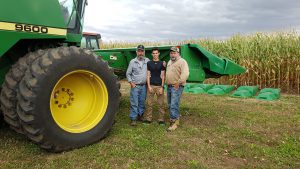Passing on the farm
DEVELOPING A PLAN FOR THE FUTURE

ABOUT THIS ISSUEGrain Farmers of Ontario staff members often hear from our farmer-members that succession planning is one of their most top-of-mind issues. Our 2018 farmer-member survey reiterated that, with many respondents indicating they would like to see more information and hear more stories from fellow farmers who have completed or are going through succession planning. That is why we have dedicated this magazine to the topic of succession planning. We highlight important considerations such as the need for legal, financial, and emotional support, what to look for in an advisor, and business planning for the next generation. We also share five stories of succession planning, each with their own challenges and outcomes. Many topics have additional information than what can fit on these pages, and we encourage you to go to www.ontariograinfarmer.ca for more on succession planning. |
SUCCESSION PLANNING BEGINS and ends with your will, say farm transition experts, and that means viewing legal agreements as living, non-static documents. Indeed, updating your will and succession plan to reflect changing business and personal circumstances is central to effective transition management.
Understanding what those circumstances are, however, requires clear communication.
According to Jon Barnett and Ted Oldfield, lawyers specializing in farm succession and estate planning based out of Strathroy and Waterloo, respectively, the most important step farm families can take in succession management is discussing tough subjects clearly — as well as revisiting them occasionally to make sure everyone is on the same page.
MAKE A WILL
While commonly an afterthought in succession planning, Barnett says having a will in the first place is critical. This helps prevent transition-related complications if, for example, the exiting parent(s) becomes incapacitated before a plan can be formalized.
Once in place, the will can then be revisited and changed to align with transition plans.
Discrepancies between a will and succession plan can happen if one is not kept up-to-date with the other. According to Oldfield, contracts among family members that are built into succession plans (e.g. shareholder agreements) help negate these issues. But if the will conflicts and nothing contractual exists, the succession plan could be damaged.
“Updating the will is part of a succession plan,” he says.
BEGIN PLANNING EARLY
In general, Barnett says succession planning should begin as early as possible.
“If people aren’t thinking about these things until it’s actually time to retire, then it’s too late,” he says. “You can learn from your collective community so you don’t make the same mistakes.”
Not beginning to plan until later in life isn’t a complete failure, however. It just means there is a shorter period in which the transition can take place.
“You can’t be afraid to hand over the reins,” says Barnett.
Barnett notes it is important farm advisors are engaged in the early stages of planning in order to avoid some pretty significant legal hurdles that could alter the plan in unexpected ways. He adds advisors should not be allowed to takeover the planning process and encourages the individuals involved to speak up if they have questions or opinions.
Oldfield expresses a similar sentiment, saying meeting with both your accountant and lawyer early is the next most important step after defining succession goals. If a family determines what end-result they hope to achieve, their advisors will be able to work more effectively.
“Make sure your accountant is given enough information to keep your tax planning up to date,” he says.
COMMUNICATE OPENLY AND REGULARLY
“You can’t overemphasize dealing with the soft issues at the beginning,” says Barnett, referring to harder-to-quantify aspects of succession planning. This can include how the outgoing generation’s retirement will be funded, how those taking over operations will be paid, management responsibilities, and what general expectations — financial or otherwise — each stakeholder has.
More concrete quantifiable issues, such as corporate reorganization and potential tax implications, can then be discussed more effectively.
“If you don’t deal with the soft issues, it becomes an issue later on because people have different expectations,” says Barnett. Ensuring everyone understands the overall financial picture, including what shares or payments they will receive, also helps reduce confusion.
“Uncertainty is a huge stressor. The sooner you give someone certainty about their role in the operation, the better for everyone involved,” he says.
FLEXIBLE PLANS
Barnett says some of the most successful succession-oriented farm families hold regular business meetings (once a week, or at least every 30 days) to discuss operations and potential changes to the plan and business. This illustrates how succession plans are living documents that should be revisited to accommodate changing circumstances — if a child decides to return to the farm after an extended period away, for example.
“Once you get a plan in place it needs to be revisited every three to five years, maybe more frequently if something significant happens to one of your stakeholders,” says Barnett.
Uninitiated, unfinished, and out-of-date succession plans are a common cause of strife in Oldfield’s experience. Consequently, he reiterates the importance of both starting — and finishing — a plan.
“Many plans are short term. If the child taking over the farm is 23 the plan will be different when he is 33,” he says.
PROTECTING YOURSELF
The exiting party in any succession plan still needs to protect their future, not to mention the future of the farm. Both Barnett and Oldfield say shareholder agreements (in farm corporations) is a commonly used strategy. Securing gifts or loans with a mortgage on property is another.
Oldfield also says creating a “dual will” — where probate tax can be lawfully avoided on certain assets, such as shares held by a privately held farm corporation — can also be employed. Ensuring one’s power of attorney is up to date, and that the person being appointed understands the business, is another.
Life insurance, too, can be used to address issues regarding inheritance and non-farming children (they can inherit the life insurance instead of the farm).
“It’s not a one-size-fits all solution, but for many families it’s an important part of the puzzle,” says Oldfield, again stressing the need to create a degree of fairness between farming and non-farming children.
Barnett adds showing one’s ongoing involvement in the financial health of the business — by participating in regular business meetings, for example – is good.
“Operations need to be managed like a business,” says Barnett.
FINANCIAL MANAGEMENT TOOLS FOR RETIREMENT
Jeanine Moyer
Managing retirement funds requires a different approach to managing farm finances.
“It’s important to assess your risk tolerance before making any financial investments,” says Mike D’Alessandro, certified financial planner with Park Place Financial. “Some retiring farmers have taken a lot of risks throughout their farming career, leaving them with a low tolerance for risk with their retirement funds.”
Here are some recommended financial management and savings tools to consider. Be sure to seek professional advice from your bank or financial advisor to evaluate your individual needs.
INVESTMENT AND FINANCIAL PLANNING TOOLS
- Government pensions — including Canada Pension Plan (CPP) and Old Age Security (OAS) — be sure to consult your financial advisor to plan ahead and carefully evaluate when you want to start collecting from these pensions.
- Tax Free Savings Account — a tax assisted savings option.
- Registered Savings Plan — another tax assisted savings option. Investments and withdrawals should be made carefully, depending on your tax bracket.
- Private pension – if available, often obtained from off-farm income or previous employment.
- Non-registered savings plans and investments – including real estate, mutual funds, GICs, etc.

























